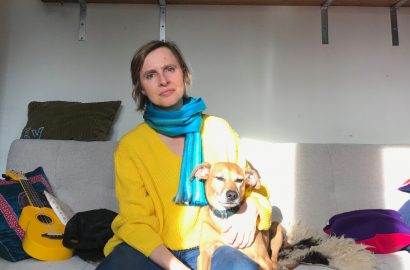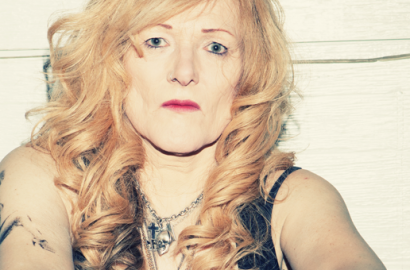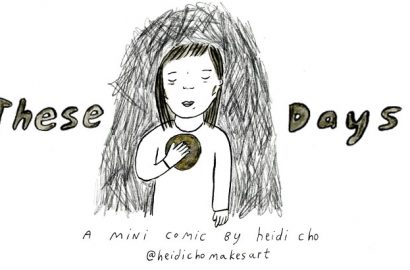Listen to an audio version of this essay, here:
I received a donated Good Food Box from an organization that supports workers on the margins, as an effort to minimize food insecurity during the times of COVID19 – aka the virus god. I am reminded of receiving loot bags after birthday parties as a child, or getting the courage to scrounge enough change for the surprise bag from Claire’s. What wondrous bounty would I find therein? …
I open the box, peering inside at the sprawled fresh produce, it smells like wet soil, and there it is, the heaviest of the items… a cabbage.
Not something I would usually buy on my own grocery trip because of the struggle to carry it home with other essential items.
A trip for a cabbage would be its own solo event.
Over the next week, I cut the prized vegetable and include it in various meals. My girlfriend and I discuss the way cabbage is helpful for food insecurity because it can ‘go a long way’…
As I stand over the counter, chopping it, mesmerized by the spiral patterned like body parts, brains or intestines, thinking about how there is magic in the uniqueness of every cabbage, my Japanese knife graciously thinning the vegetable into long sinewy strips, I am abruptly interrupted by the feeling of high-pitched-tinfoil-stiff-screaming all over, my temperature climbing, sweat building and there is a stream of serene blood dripping from my finger…
I go to the washroom to grab a towel to put pressure on my finger, and sit at the kitchen table to take deep breaths, as I feel the walls closing in on me. Before I know it, I wake up stomach flat on the floor from a deep sleep and the last thing I hear is my own voice from a distance, in a dream, discussing the importance of a pair of good fitting pants…
Once I realize I have just fainted and hit my head on the floor, I call for my girlfriend. She is woken up from a nap to this surreal image of cabbage all over the counter, blood splattered on the floor around my body, as I am shaking in tears, like a scene out of a campy horror flick.
After she consoles me in her warmth, I start describing first-aid instructions. Eventually, I am calmed by our collaborative ritualized phone calls to various medical contacts in our networks
The sweet dance of reassurance knowing we’ve successfully avoided a trip to the emergency room.
For many disabled people, especially psychiatric survivors (because of our lives and choices being scrutinized under the Mental Health Act of Ontario), finding creative ways to avoid the emergency room is status quo, but in the times of the virus god we really don’t feel we have a choice.
Unless we have been touched by the virus, itself.
I couldn’t tell how long I was passed out: an important criteria to grasp the severity of the concussion that ensued. The experience of time is relative to the body that inhabits it.
For Mad, Deaf, Blind, Disabled, Neurodiverse, and Chronically Ill folks the movement of time is theorized by Alison Kafer, in Feminist, Queer, Crip as, Crip Time. For instance, pain, discomfort, and/or distress may contribute to the way time is perceived. The medications and/or drugs taken to ameliorate conditions can be an additional altered state that bends the apprehension of wristwatch numbers and cellphone alarms. The structurally imposed issue of “waiting for” is a common experience in many disabled folks lives by way of waiting for care and resources to access in(ter)dependent living: elevators, assistive technologies, government agencies’ responses to funding requests, medical specialist appointments, the snow to be cleared, the Social Benefits Tribunal, an affordable accessible apartment, an affordable or pro-bono therapist or lawyer, The Summer, etc…
This is all said without factoring in the arrival of the virus god and the complications of quarantine. This is just… crip life.
My medication, existential dread and distress, perception of space, and energy levels, also called “spoons”, contribute to how I experience time.
Christin Miserandino’s Spoon theory provides an analogy for what it is like living as a chronically ill, mad and/or disabled individual. The idea is that we start our day with a number of spoons, influenced by the amount of energy we may feel we have upon waking, and throughout the day, depending on the physical, emotional, or spiritual tasks we are confronted with, we give away our spoons. Sometimes, we lose our spoons, or they just even disappear …into thin air.
For some, spoons can be replenished by participating in activities that provide a sense of renewal or regeneration. Self-described ‘spoonies’ are people in disability community that use this framework to communicate how the experiences of living and performing tasks, no matter the size, consume energy.
Domestic tasks considered by many as ‘basic,’ such as cleaning, cooking, and laundry, require many spoons, however this can be impacted by what other things are occupying life… Emotional labour, processing feelings, sometimes visible and other times invisible, layered onto the indeterminate amount of time it takes to do a task, can create more time, lost or found, gone into the crip time vortex of spoons. Shoved down as shame, (internalized ableism), for being ‘different’…
Together, crip time and spoon theory are a way of naming experiences, which can have the potential to provide solace when using a shared way of describing phenomena that is inherently unquantifiable, intangible, and distinct to the body that holds life. Asserting ‘spoons’ as a new kind of relation to time, and energy, flips a normative understanding of how the body has “capacities”[1].
A ‘spoon’ is a kind of ‘output’ then – it is an abstract placement, it can be emotional, physical, spiritual, etc. from making a cup of tea, fixing a broken wheel, blowing into a trombone, to discussing grief. Capacities are often measured in order to amount to outcomes. Thus, capacities are often positioned alongside the hierarchy of ‘productivity’.
But, a spoon … well, a spoon is like the sound of a yonic embrace…
The crip time vortex of spoons is an embodied experience of disabled life that confronts assumptions of productivity as a value of normalcy. Productivity being measured by outputs and efficiencies, for instance, how long it takes to create an expected output like, washing hands. Sara Ahmed writes in Queer Phenomenology, about the spatial relations of objects and bodies, and builds on Merleau-Ponty’s ideas to theorize how bodies can be not only tools through which we grasp objects, but also vessels through which we direct our intentions. Therefore, bodies manifest our being. Disabled bodies have notoriously been seen as dirty, un-clean, or unsanitary. Even the term of old, “Sanitarium” implies a need for cleansing, a hop-skip-and-a-jump from the timeless term, “Eugenics”. They sound different, but mean practically the same.
The arrival of the virus god has meant insurmountable grief. Unmarked graves in ‘developed’ countries. Necropolitics visible on a global scale; the way death is manufactured bythe very real eugenics involved in things like hospital protocols for elderly and disabled folks, separated from support workers and care networks upon arrival in Ontario and beyond, among other pressing inequities.
In an online meeting of crip artists, we begin with the repeating of the important instructions on how to include everyone’s voice, “say end of thought when you are finished speaking,” “mute your mic when you aren’t talking,” “use the ‘raise your hand’ icon for the meeting moderator to put you on the speakers list,” sometimes we even spell for the interpreters.
We are finding that in the time of necropolitics and the virus god, another kind of visibility is occurring: the importance of disability justice. For example, the creation and maintenance of mutual aid networks, which is not just an autonomous anarchist practice, it is and has always been, generations of care work by Indigenous, Black, and People of Colour, especially taken up by Two-Spirit, femme, feminised people, and cis-women.
A disabled life during the pandemic doesn’t always feel that different, there’s just more grief in knowing we may not have all of our friends and community members alive by the time the virus god has gone dormant – especially, for Poor and racialized members of the disabled community. There is more isolation and out-in-the-open racism and ableism than usual, but there is also a feeling of more present and pressing, grassroots community effort, swelling with solidarity.
I pause for a moment and feel myself smiling in the group chat we are having about the structural issues of institutionalization, us all knowing very well (from our own experiences) that institutions do not work!!!… and we all confirm how labour rights are connected to disability justice. We talk about how we should be doing more to stick up for Personal Support Workers who experience so much injustice within a deeply flawed medical system, and most pressingly Long-Term Care system workers in Ontario, knowing very well that many of these PSWs carry their own colonial legacies of being care workers, and even nurses with degrees that go unrecognised in Canada. We lament how it isn’t the fault of any one of these individual workers, but the management of institutions… We take the leap from discussing the challenges of Long-Term Care to say that the commonality between all of these spaces of containment is the use of restraints and seclusion. Many health care workers do not even feel comfortable or ethical with these violent practices being regular duties, and then the next stop on the journey of the dialogue about how institutions do not work, is prison, where solitary confinement and isolation is societally defined as acceptable revenge. What will be done to prevent the virus god from mutating in between the cells of inmates?
When we get into these conversations of institutional critique, we always end up in the same place, how we must work to ABOLISH.
… Are we swimming in circles? Stimming[2] in our seats? Repeating ourselves to feel better? Working on being present in the collective struggle? Fighting a losing battle?
The vortex, a spiraling whirlwind of turbulence, shaped like a three-dimensional rotating spiral, alludes to space. Space in the context of how both spoons and crip time are used as signifiers of crip experience. The development of shared language, on its own, is an example of ‘cripping’ space, but also in thinking about space as a conceptual arena. The solar system, and the many vortices contained within it, are in a perpetual state of ordered chaos.
The crip time vortex of spoons is an ordered chaos.
It’s a beautiful mess. The mad, disabled and chronically-ill life, a place of vulnerability and marginality, is inseparable from a world where merely existing can be laborious.
Irrespective, we live, we fight on…
The virus god is a result of climate disaster, and food insecurity, especially in the Global South, where food insecurity has always been an issue, and is now worsened because of the virus god.
As Arundhati Roy says, “The pandemic is a portal”!
…But where will it take us? What are we waiting for?
We cannot just stand, or sit, or kneel, or lay down, to die, alone.
Notes
[1] (Dhand, 2009). Under the Consent and Capacity Board of Ontario, the measurement of “capacity” is an issue of disability rights and freedoms.
http://www.ccboard.on.ca/scripts/english/aboutus/index.asp
[2] Agony Auntie. (2018, October, 25). Stimming, What’s That? https://www.youtube.com/watch?v=8bhT2R9HiLs
References
Ahmed, S. (2006). Queer Phenomenology: Orientations, Objects, Others. London: Duke University Press.
Dhand, R. (2009). Challenging exclusion: A critique of the legal barriers faced by ethno-racial psychiatric consumer/survivors in Ontario (Unpublished LLM Thesis). University of Toronto, Ontario, Canada.
Democracy Now. (2020, April, 16). Pandemic Is a Portal: Arundhati Roy on COVID-19 in India, Imagining Another World & Fighting for It. https://www.democracynow.org/2020/4/16/arundhati_roy_coronavirus_india
Kafer, A. (2013). Feminist, Queer, Crip. Indiana: Indiana University Press.
Merleau-Ponty, M. (2002) Phenomenology of Perception. Routledge & Kegan Paul Limited: London.
Miserandino, C. (2003). The Spoon theory. Retrieved from www.butyoudontlooksick.com.
Roy, A. (2020, April, 3). Arundhati Roy: ‘The pandemic is a portal’. Financial Times. https://www.ft.com/content/10d8f5e8-74eb-11ea-95fe-fcd274e920ca
Related posts

It’s Going to Take Time

Exiled


